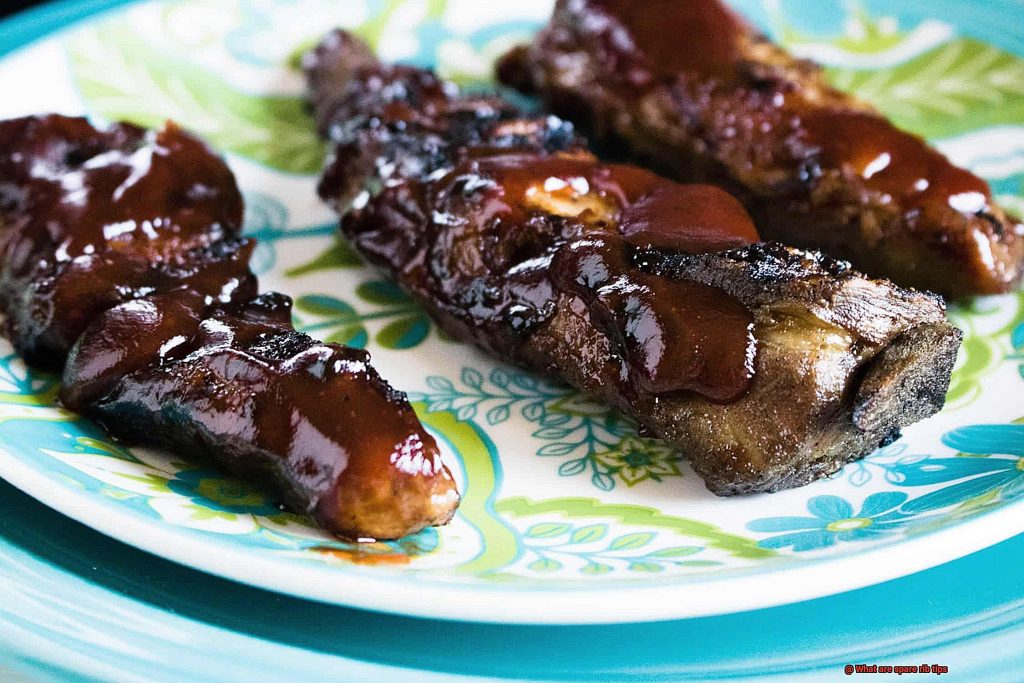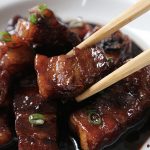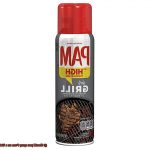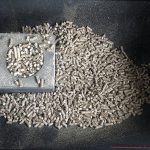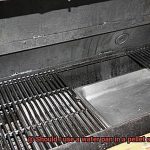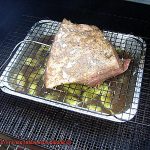Are you a carnivore in search of a new, mouthwatering dish to add to your recipe repertoire? Look no further than spare rib tips. These delectable morsels are a lesser-known part of the pork rib section but are bursting with flavor and perfect for any barbecue or grill-out.
But what exactly are spare rib tips? They’re the triangular, cartilage-rich ends of pork spare ribs. Often overshadowed by meatier and more familiar cuts, spare rib tips are a delicacy in their own right. They’re chewy, succulent, and packed with the flavors that make pork a favorite among meat lovers.
One reason why spare rib tips have remained under the radar is that they require additional preparation to bring out their full potential. However, armed with the right recipe and a little bit of patience, you can transform these humble meat scraps into a tantalizing feast.
Whether you’re an experienced pitmaster or a home cook eager to try something new, spare rib tips are an excellent choice for your next meal. In this post, we’ll delve into everything you need to know about spare rib tips. From where to find them to best practices in cooking them for optimal texture and taste – we’ve got you covered. So buckle up and get ready to savor every bite of this delicious dish.
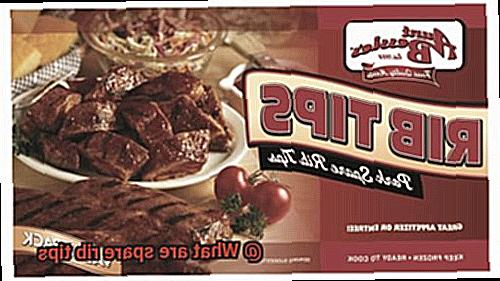
Contents
Anatomy of Spare Rib Tips
Understanding their anatomy is crucial for preparing them perfectly, so let’s break it down into five sub-sections.
Bones and Cartilage:
Spare rib tips are taken from the lower end of pork spare ribs and consist of bones and cartilage that connect the ribs to the breastbone. The bone in the tips is thin, flat, and delicate, making it essential to handle them with care during preparation. The cartilage gives them their unique texture and flavor, which sets them apart from other cuts of meat.
Meat:
The meat on spare rib tips is typically tougher and chewier than other parts of the rib. However, it is also juicier and more flavorful due to the marbling of fat throughout the meat. To ensure even cooking and maximum flavor, it’s important to trim any excess fat or gristle before cooking.
Thickness:
The thickness of the meat and fat on spare rib tips can vary depending on how they are trimmed. Some cooks prefer to leave more fat on the meat for added flavor and tenderness, while others prefer a leaner cut. Regardless of your preference, trimming them carefully ensures even cooking and maximum flavor.
Connective Tissue:
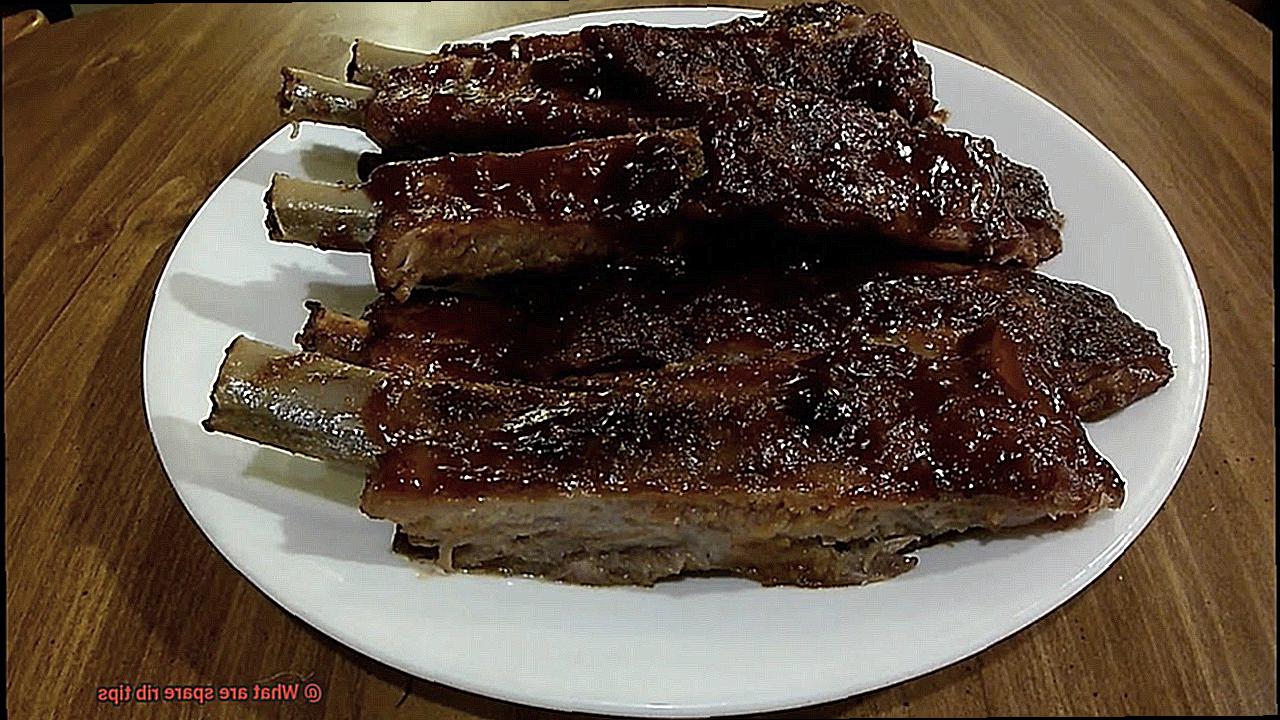
Spare rib tips contain more connective tissue than other cuts of meat, which can make them tough if not cooked properly. However, slow-cooking or smoking can break down the connective tissue and create a delicious texture that melts in your mouth.
Cooking Techniques:
Spare rib tips are versatile and can be cooked in several ways, including grilling, smoking, baking, or frying. They are often seasoned with a dry rub or marinade to enhance their flavor before cooking. Low and slow cooking techniques are ideal for spare rib tips as they break down the connective tissue and create a tender texture.
In conclusion, understanding the anatomy of spare rib tips is crucial for preparing them perfectly. By handling them carefully, trimming excess fat or gristle, and slow-cooking or smoking, you can transform them into a delicious and satisfying meal for any barbecue or grilling enthusiast.
Differentiating Spare Rib Tips from Other Cuts of Meat
Spare rib tips are a cut of pork that are becoming increasingly popular among grill masters and home cooks alike. But what sets these meaty morsels apart from other cuts of pork? Let’s dive into the details.
Shape and Size:
Spare rib tips have a unique shape and size compared to other pork cuts. They are rectangular pieces that are about 2-3 inches long and 1 inch thick, with some bone attached. This makes them shorter and thicker than traditional spare ribs, which are long and thin. Other pork cuts like pork chops or tenderloin are usually bone-in and have a different shape altogether.
Texture and Flavor:
The real difference between spare rib tips and other cuts of pork is their texture and flavor. Spare rib tips are more tender and succulent due to their higher fat content, which also gives them a richer flavor. This is why they are perfect for grilling or smoking, as they can become even more tender as the fat renders down. Other cuts of pork, like loin or shoulder, may be leaner and have a tougher texture.
Preparation:
When it comes to preparation, spare rib tips require a bit more attention than other cuts of pork. Unlike quick-cooking cuts like pork chops, spare rib tips need to be cooked low and slow to allow the fat to render and the meat to become tender. This is why they are often grilled or smoked for an extended period of time. The end result is a mouth-watering dish that’s worth the extra effort.
Versatility:
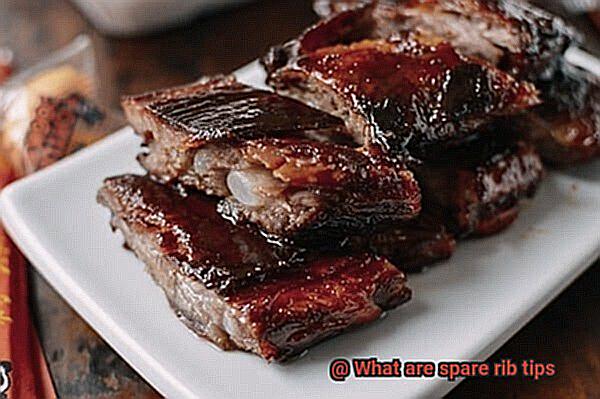
Spare rib tips are a versatile cut of meat that can be prepared in a variety of ways. They can be marinated, dry-rubbed, or glazed with your favorite sauce to add even more flavor. They can also be served as an appetizer or a main course, making them perfect for any meal or occasion.
Preparing and Cooking Spare Rib Tips
If you’re looking for a delicious and underrated cut of meat to grill, spare rib tips may just be the answer. These smaller, leaner cuts of pork are packed with flavor and can be a hit at any outdoor gathering. However, before you start cooking, there are a few important steps to follow.
The first step in preparing and cooking spare rib tips is to properly trim and clean them. Using a sharp knife, carefully remove any excess fat, silverskin, or bone fragments that may be present on the meat. This will not only improve the appearance of the meat but also ensure it cooks evenly and without any unwanted chewy bits.
Once your spare rib tips are trimmed and cleaned, it’s time to add some flavor. Applying a dry rub is an easy way to infuse some delicious spices into the meat. Try mixing up salt, pepper, paprika, garlic powder, and onion powder for a tasty blend that will take your spare rib tips to the next level. Be sure to apply the dry rub generously to both sides of the meat and let it sit for at least an hour before grilling or smoking.
When it comes to cooking spare rib tips, there are several options available. Grilling is a popular choice as it imparts a smoky flavor and creates a nice charred exterior. However, it’s important to cook the meat over indirect heat to prevent burning and ensure even cooking. Grill the spare rib tips for around 5-7 minutes per side or until they reach an internal temperature of 145°F.
If you’re looking for a more unique flavor profile, smoking your spare rib tips may be the way to go. Smoking allows the meat to cook low and slow over hardwood, resulting in tender, juicy meat that falls off the bone. To smoke your spare rib tips, apply your dry rub and let them sit in the refrigerator overnight. The next day, preheat your smoker to 225°F and place the meat on the rack. Smoke for approximately 3-4 hours or until they reach an internal temperature of 190-200 degrees Fahrenheit.
Marinating for Flavor and Tenderness
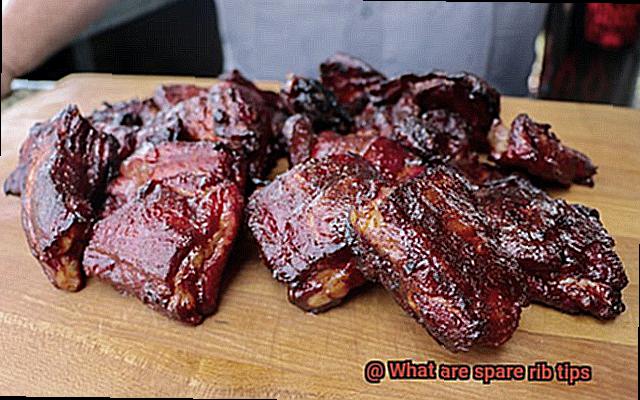
As an expert on the subject, I can tell you that marinating is a game-changer when it comes to adding both flavor and tenderness to your meat.
So, what exactly is marinating? At its core, it’s all about soaking your meat in a flavorful mixture of ingredients. This can include acidic elements like vinegar or citrus juice, oils, spices, herbs, and aromatics such as garlic and onions. The combination of these ingredients works like magic to enhance the taste and texture of your spare rib tips.
Now, let’s delve into how marinating can benefit your meat. One of the most significant advantages is that it can break down tough muscle fibers that can make the meat chewy. The acid in the marinade works its way into the meat, tenderizing it and resulting in more succulent spare rib tips.
But wait, there’s more. Marinating is also an excellent way to add depth and complexity to your dish. The longer you marinate your meat – ideally overnight – the more time it has to absorb all those delicious flavors from the marinade. The possibilities are endless when it comes to creating unique flavor combinations – from sweet and savory to spicy and tangy.
To get started with marinating your spare rib tips, make sure you use a non-reactive container such as a plastic bag or glass dish. You’ll want to ensure that the marinade completely covers the meat and let it rest in the refrigerator for at least 2 hours (overnight is even better.) to maximize flavor and tenderness.
Grilling or Smoking Spare Rib Tips
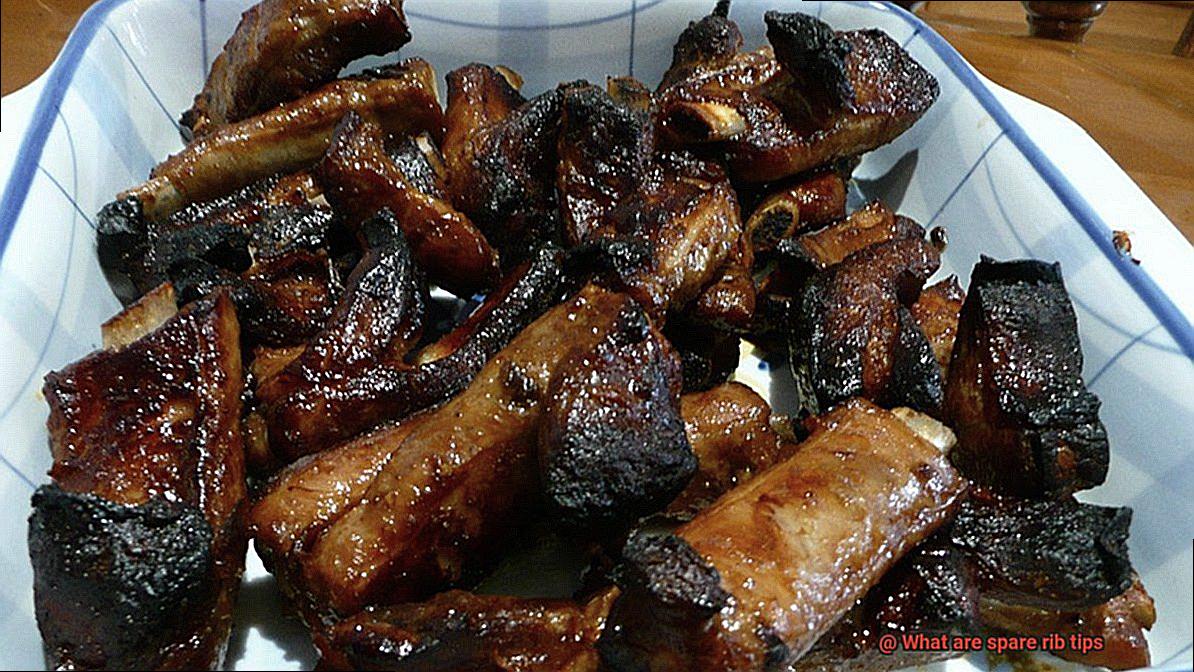
Grilling or smoking spare rib tips is a mouth-watering way to enjoy this flavorful cut of meat. Spare rib tips are the meaty, cartilaginous ends of pork spare ribs that are trimmed off when preparing spare ribs. These tips are often sold separately and can be cooked in a variety of ways, including grilling and smoking. In this article, we’ll explore the differences between grilling and smoking spare rib tips to help you decide which method is right for you.
Grilling Spare Rib Tips
Grilling spare rib tips involves cooking the meat over high heat for a short amount of time. This method is perfect for achieving a charred exterior while keeping the inside juicy and tender. Before grilling, it’s essential to season the spare rib tips with your desired flavors. You can use dry rubs, wet marinades, or a combination of both to add flavor and enhance the taste of the meat.
To grill spare rib tips, preheat your grill to high heat. Once hot, place the seasoned meat on the grill and cook for 4-5 minutes on each side until charred and cooked through. It’s important to monitor the temperature of the meat using a thermometer to ensure that it’s cooked safely and properly. The internal temperature should reach 145°F for safe consumption.
Smoking Spare Rib Tips
Smoking spare rib tips involves cooking the meat slowly over low heat using a smoker. This method infuses the meat with a smoky flavor and makes it incredibly tender. It’s recommended to use hardwoods like hickory, mesquite, or applewood for smoking spare rib tips. These woods add flavor and aroma to the meat while also helping to tenderize it.
To smoke spare rib tips, first season them with your desired flavors. Then, place them in the smoker and cook at a low temperature (around 225°F) for several hours. The length of time depends on the size and thickness of the meat. It’s essential to monitor the temperature of the meat using a thermometer to ensure that it’s cooked safely and properly.
Which Method is Right for You?
So, which method should you choose? It depends on your personal preferences and cooking style. Grilling spare rib tips is perfect for achieving a charred exterior and juicy interior in a short amount of time. It’s also a great option if you don’t have access to a smoker.
On the other hand, smoking spare rib tips takes more time and equipment, but the end result is incredibly flavorful and tender. This method is perfect for those who enjoy the smoky flavor that only a smoker can provide. The smoking process infuses the meat with a smoky flavor and makes it tender and juicy.
Baking or Braising Spare Rib Tips
Spare rib tips are a delicious and tender cut of meat that can be cooked in a variety of ways, including baking and braising. Each method has its own benefits and can result in unique flavors and textures. Let’s take a closer look at the differences between baking and braising spare rib tips.
Baking spare rib tips is a simple and easy method that involves cooking the meat in an oven at a low temperature for an extended period of time. This allows the meat to cook slowly and become tender while still maintaining its juiciness. Baking is great for those who prefer a crispy exterior on their meat, as it can create a delicious caramelized crust on the outside. To bake spare rib tips, simply season them with your favorite spices and marinade, then place them on a baking sheet lined with parchment paper. Bake them in the oven at 325°F for about 2-3 hours or until they reach an internal temperature of 145°F.
On the other hand, braising spare rib tips involves cooking them slowly in a liquid such as broth or wine over low heat. This method is great for those who want to achieve a more tender and flavorful result. Braising allows the meat to absorb the flavors of the liquid and any added vegetables or herbs, resulting in complex flavors and textures. To braise spare rib tips, start by searing them on both sides in a pan with oil over medium-high heat. Once browned, remove them from the pan and set aside. Add your liquid of choice to the pan along with any additional seasonings or vegetables. Bring it to a simmer, then add the spare rib tips back into the pan. Cover with a lid and let it cook on low heat for about 2-3 hours or until they are tender.
Both methods have their own benefits depending on your preferences and available time. Baking is quicker and requires less active attention, making it a great option for a busy weeknight meal. Braising, on the other hand, requires more time and attention but can result in more complex flavors and textures. Ultimately, it comes down to personal preference and experimenting with different methods to find what works best for you.
Benefits of Eating Spare Rib Tips
Spare rib tips are a versatile and flavorful cut of pork that often get overlooked. However, there are several benefits to adding this tasty protein to your diet. Here are five sub-sections outlining the many benefits of eating spare rib tips:
High Protein Content
Spare rib tips are an excellent source of protein, making them a perfect choice for athletes or anyone looking to increase their protein intake. A 3-ounce serving of spare rib tips contains approximately 22 grams of protein, which is essential for building and repairing muscle tissue. Protein also helps to keep you full and satisfied, making it an excellent choice for anyone trying to maintain a healthy weight.
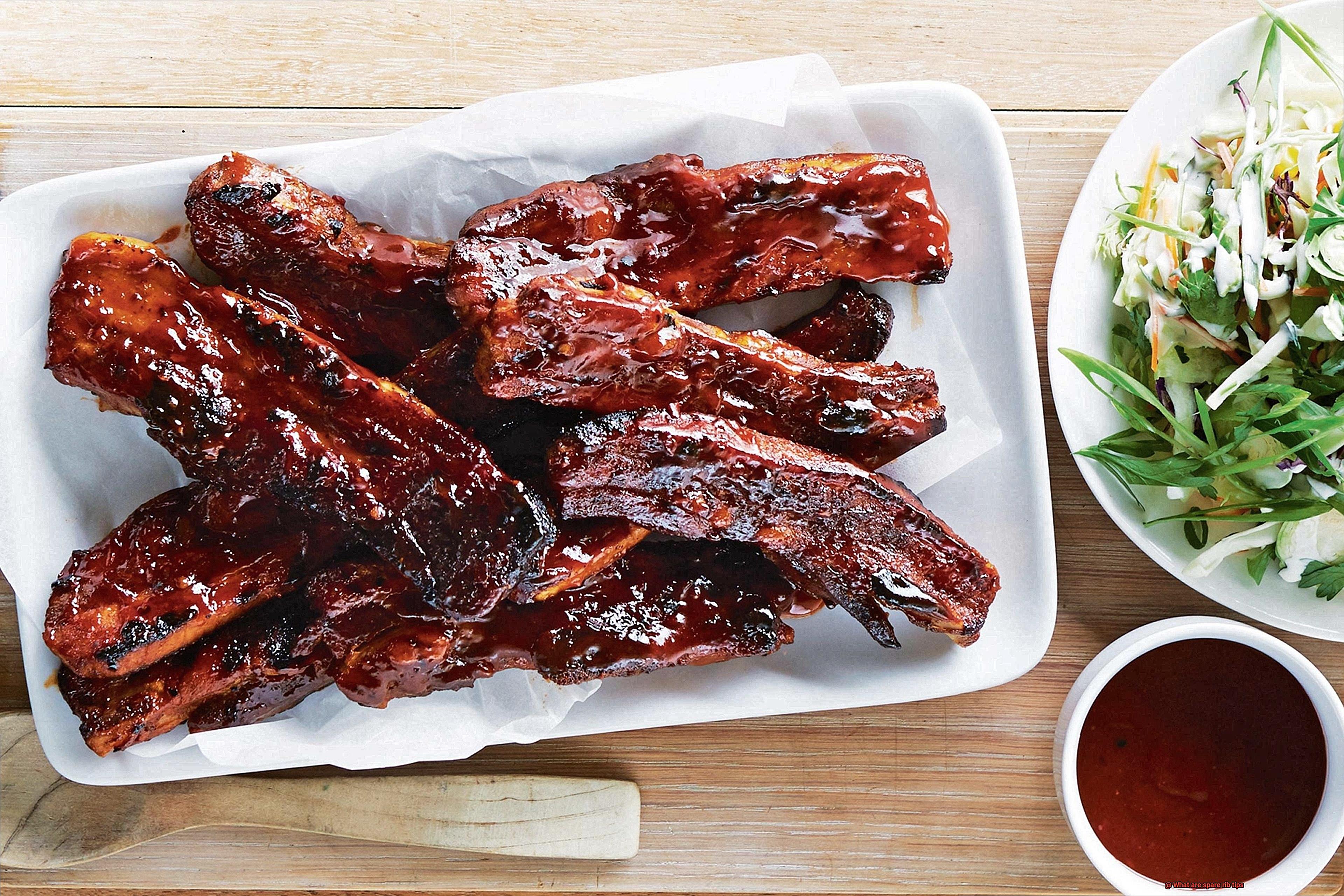
Rich Flavor
Spare rib tips are packed with flavor thanks to their marbling and connective tissue. When cooked correctly, they are juicy, tender, and bursting with savory goodness. Unlike other cuts of pork that can be dry and bland, spare rib tips offer a mouth-watering taste experience that will leave you craving more.
Essential Vitamins and Minerals
Spare rib tips are an excellent source of essential vitamins and minerals that play a crucial role in maintaining overall health. These include thiamin, niacin, vitamin B6, phosphorus, zinc, and selenium. Thiamin is important for maintaining healthy nerve and muscle function while niacin helps to lower cholesterol levels. Vitamin B6 is involved in the production of neurotransmitters that regulate mood and behavior, while phosphorus is essential for strong bones and teeth. Zinc and selenium are important for immune system function and wound healing.
Versatility
Spare rib tips are incredibly versatile and can be prepared in a variety of ways to create a delicious meal. They can be grilled, smoked, baked or braised to add flavor and tenderness to any dish. Whether you’re hosting an outdoor barbecue or preparing a comforting winter meal, spare rib tips can be a crowd-pleasing addition to any menu.
Crowd-Pleasing Addition
Spare rib tips are a delicious and satisfying addition to any meal. With the right preparation and cooking techniques, they can add flavor and variety to your grilling repertoire. Whether you’re serving them up at a family gathering or enjoying them on a quiet night in, spare rib tips are sure to delight your taste buds.
Common Mistakes When Cooking Spare Rib Tips
Spare rib tips are a delicious and flavorful cut of meat that can be tricky to cook. However, by avoiding some common mistakes, you can ensure that your spare rib tips turn out tender and delicious every time. Here are five common mistakes to avoid when cooking spare rib tips:
Mistake #1: Improper Meat Preparation
One of the most common mistakes people make when cooking spare rib tips is not preparing the meat properly before cooking. It’s important to trim excess fat and remove the membrane on the underside of the ribs. The membrane, if left on, can make the meat tough and chewy, and prevent marinades and rubs from properly penetrating the meat.
Mistake #2: Inadequate Seasoning
Spare rib tips can be quite bland on their own, so it’s important to use a good seasoning blend or marinade to add flavor. However, it’s important not to overdo it with the seasoning as this can overpower the natural flavor of the meat. Strike a balance between seasoning and enhancing the natural flavor of the meat.
Mistake #3: Short Cooking Time
Spare rib tips require a slow and low cooking method, which means they need to be cooked for several hours at a low temperature to achieve the desired tenderness. If they are cooked too quickly or at too high of a temperature, they can become tough and chewy. Plan ahead and allow enough time for your ribs to cook low and slow.
Mistake #4: Overcooking
While undercooking spare rib tips can result in tough meat, overcooking them can also be a problem. Spare rib tips should be cooked until they reach an internal temperature of around 145-165°F using a meat thermometer, and then allowed to rest for a few minutes before serving. Overcooking can result in dry, tough meat that isn’t as enjoyable to eat.
Mistake #5: Skipping the Resting Time
Allowing spare rib tips to rest for a few minutes after cooking allows the juices to redistribute throughout the meat, resulting in a more flavorful and tender final product. Skipping this step can result in dry, tough meat that isn’t as enjoyable to eat. Letting the meat rest also helps to retain all the flavors and juices.
ffE1tGj4EBA” >
Conclusion
In conclusion, spare rib tips are a delicious and often overlooked cut of meat from the lower portion of pork ribs.
Whether grilled, smoked, or slow-cooked, spare rib tips are a versatile and satisfying addition to any barbecue or meal.

